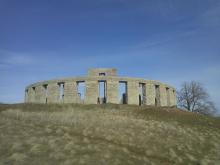Listen to today's episode of StarDate on the web the same day it airs in high-quality streaming audio without any extra ads or announcements. Choose a $8 one-month pass, or listen every day for a year for just $30.
You are here
Nabta
For the people of southern Egypt, the summer solstice once was a time to gather. The monsoon season began about then, bringing enough rain to create shallow lakes. People gathered to water their cattle, and to offer sacrifices to the gods. So it was important to know when the solstice was coming.
At one site, people built what may have been a calendar — a ring of small stones. Some of the stones pointed north, while others aligned with the sunrise on the solstice. And some may have pointed to the rising points of bright stars.
Nabta Playa is near the southern border of Egypt, about 65 miles west of the Nile River. Excavations have shown that the site was inhabited as early as 7,000 years ago. People built structures and dug wells. They also dug burial pits and quarried sandstone. Some of the rocks were used in the calendar circle and the possible sightlines to the stars.
These structures weren’t on the scale of Stonehenge. Most of the rock markers were only a few inches to a few feet tall. And the calendar circle spanned only about 12 feet. Yet that would have been enough to sight the rising of the Sun and stars at key times of the year.
The rocks may have been aligned with Arcturus, Sirius, and Alpha Centauri — three of the brightest stars in the night sky. These alignments could have helped the people of Nabta keep time with the seasons — and with the life-giving rains of summer.
More about the summer solstice tomorrow.





